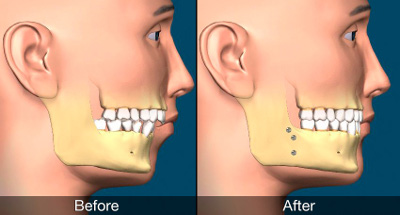When Dr. Moradi examines a patient’s jaw and determines the severity of a TMD case, she will be able to see if this individual needs surgery or if non-surgical dental procedures make more sense. First, though, what exactly is orthognathic surgery?
Orthognathic surgery

Defining Orthognathic Surgery
Surgery to correct the jaw is called orthognathic surgery. Specifically, the surgery centers on fixing irregularities of the upper jaw (maxilla) and/or the lower jaw (mandible) to improve breathing, chewing and speaking. The cause of this anomaly may be a developmental defect, traumatic injury to the jaw, or have been present since birth.
Typically, jaw surgery is performed by an OMS or oral and maxillofacial surgeon. The intention of the procedure is to realign or straighten the bad bite (malocclusion) in cases when non-surgical orthodontic treatment is not an option. The orthognathic surgery can involve reconstructing the mandible, the maxilla, or both.
At our office, we will determine if your dental and skeletal irregularities can be fixed without surgery. If surgery is unavoidable, we will refer you to a surgeon.
When Jaw Surgery is Necessary
A bad bite of the teeth, when the jaws are closed, can lead to the intense tension of the muscles that control the opening and closing of the jaw. The sufferer may experience discomfort while chewing, biting, or clenching, frequent tension headaches, and more. Furthermore, this malocclusion of the teeth can significantly damage not only the appearance of the teeth but also how they function if a solution is not sought.
Some of the effects, if the issue is left untreated, are:
- Worn-down teeth – An overbite can result in teeth being worn unevenly due to excess pressure
- Loosening of teeth – The uneven pressure can damage soft tissue and loosen teeth in their sockets
- Increased tooth sensitivity – As tooth become damaged, the enamel gets thinner and exposes nerves; the result is sharp pains when eating cold or hot foods
- Chronic jaw and muscle pain – Misaligned teeth affect how the jaw functions and muscles relate to each other; damage can occur to meniscus cartilage between the jaw bones
- Problems chewing, biting, or swallowing – These actions associate with muscle discomfort and improper jaw alignment
- Frequent headaches – Bad bite can increase tension between jaws and muscles, contributing to headaches again and again
Orthognathic Surgery: What to Expect
After we refer you to a surgeon, the initial step involves this specialist determining that you are a good candidate for orthognathic surgery. Then, a complete imaging analysis is done, which can include several kinds of x-rays, such as panorex, cephalometric, and a CBCT scan.
An examination then occurs to determine how the surgery will affect jaw positioning and the appearance of the face. Typically, before surgery, orthodontic braces are worn to help line up the arches and make teeth straighter.
As for the jaw surgery itself, it differs depending on whether you have a maxillary or mandible surgical procedure. With maxillary surgery, the upper jaw is repositioned and secured in place with screws, tiny plates, rubber bands, and wires. As for the mandible surgery, the lower jaw is moved into the proper position through bone grafts.
If you have a mild case of malocclusion or poor bite and would like to learn the dental options available, call our Houston dental practice today. Depending on your case, we can recommend different solutions, including referring you to a surgeon, if non-surgical alternatives are not suitable. Call our friendly team at 713-590-9777 to book a free consultation.


